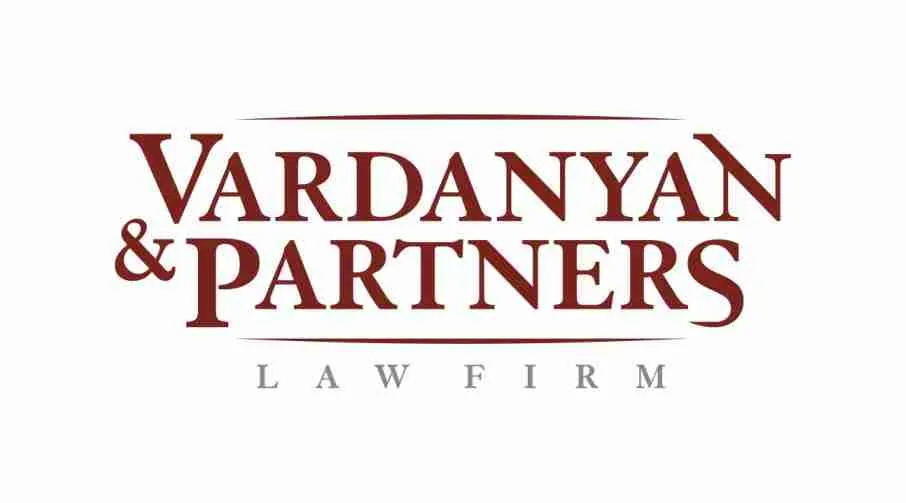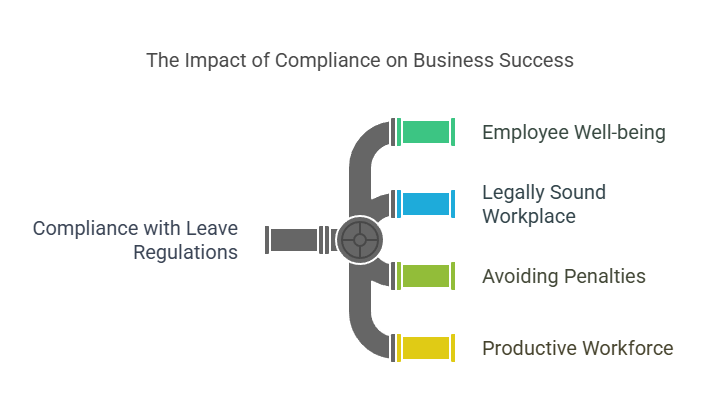Employers operating in Armenia – especially those managing international teams or subsidiaries – must navigate local labor laws to remain compliant. Two key areas are paid annual leave and public holidays, which are governed by the Armenian Labor Code. This comprehensive guide explains the rules and entitlements for annual leave and official public holidays in Armenia as of 2025, with practical examples and legal references. It is designed for HR professionals, employers, and consultants to ensure company policies meet local requirements.
Annual Leave Entitlements under Armenian Labor Law
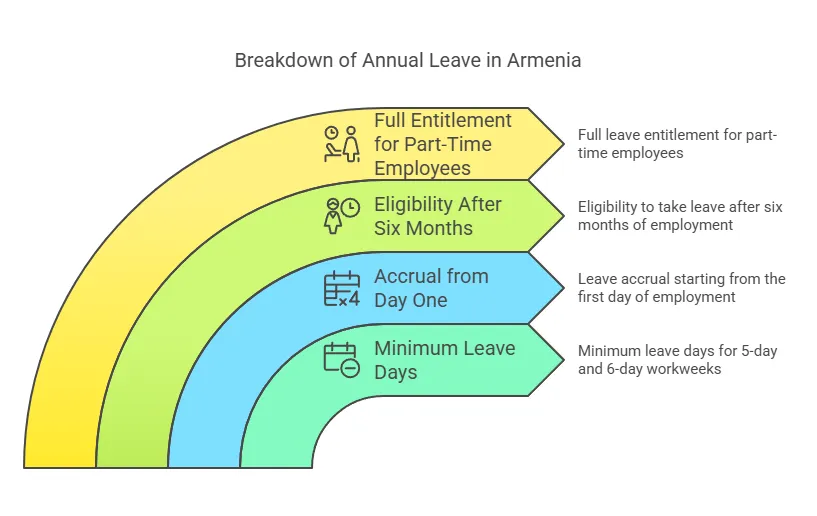
Armenian law provides generous paid annual leave to employees. The Labor Code guarantees a minimum amount of annual leave for all employees and outlines how leave is accrued, taken, and paid. Understanding these rules is crucial for compliance.
Minimum Annual Leave Duration and Eligibility
All employees in Armenia are entitled to paid annual leave – this is a fundamental right under the Labor Code. The minimum duration of annual leave for a full-time employee is 20 working days for a five-day workweek, or 24 working days for a six-day workweek. In practice, this equates to four calendar weeks of vacation per year (since a 5-day week of 20 workdays corresponds to 28 calendar days including weekends). Part-time employees are also entitled to the minimum annual leave, not prorated down – the law explicitly states that part-time status does not reduce leave entitlement.
Legal reference: Article 159 of the Armenian Labor Code defines the minimum annual leave as 28 calendar days (which corresponds to 20 working days in a 5-day week). Employers cannot offer less than this minimum. Many international employers are surprised by how high this statutory minimum is – comparable to European standards – and must adjust their company policies accordingly. For instance, a company used to giving 10 business days of vacation (common in some countries) would be non-compliant in Armenia, where the legal minimum is roughly double that.
Eligibility: Employees begin to accrue leave from the start of employment, but the Code stipulates that annual leave for the first year is typically granted after six months of continuous employment with the company. In other words, an employee becomes eligible to take their first vacation after six months on the job. However, this six-month waiting rule can be waived by agreement. The law allows employers and new employees to agree to take leave earlier within the first six months if desired (a provision especially useful for international hires or transfers who might need time off sooner). Starting from the second year of employment, annual leave can be taken at any time during the working year as per the agreed leave schedule.
Example – First-Year Eligibility: Suppose an employee joins a company in Armenia on February 1, 2025. By August 1, 2025 (after six months of uninterrupted work), they become eligible to take their annual leave for the first working year. If the employer and employee agree, the employee could even take some or all of their leave before August (e.g., a short vacation in June 2025), despite not yet reaching six months, because the law permits early annual leave by mutual consent. Without such an agreement, the employee would wait until at least August to take vacation. In the second year (2026), the employee could schedule their annual leave at any time during the year according to the company’s leave plan.
Accrual of Leave: Although Armenian law doesn’t require a monthly accrual system (it grants the full annual entitlement for each working year), many employers calculate accrual for administrative purposes. Over a 12-month period, 20 working days of leave equates to about 1.67 days per month of service. If an employee leaves the company before using all their leave, they are typically entitled to payment for any accrued but unused leave. Likewise, if an employee has worked only part of the year, their paid leave upon departure is pro-rated based on the length of service in that year.
Extended and Additional Annual Leave (Special Cases)
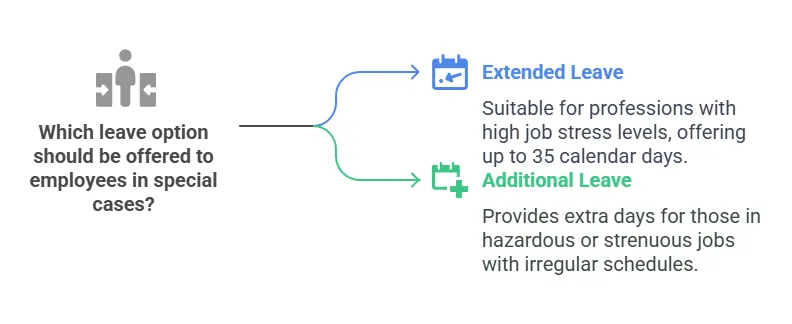
While 20 working days (28 calendar days) is the minimum for most employees, Armenian law provides extended and additional annual leave for certain categories of workers due to the nature of their work:
Extended Annual Leave: Employees in jobs that involve “great nervous, emotional and intellectual strain or professional risk” are entitled to an extended vacation of up to 25 working days in the case of a five-day work week, and 30 working days in the case of a six-day work week, (in exceptional cases: 35 working days in the case of a five-day work week, and 42 working days in the case of a six-day work week). The Government of Armenia defines which positions qualify for this extended leave. Typically, this covers jobs like teachers (who often take summer holidays), high-stress technical roles, or other roles explicitly listed by government decree. For example, university faculty might receive extended leave to coincide with academic breaks. Legal reference: Article 160 of the Labor Code allows up to 35 days for such categories.
Additional Annual Leave: Certain working conditions warrant additional leave days on top of the minimum. Article 161 of the Code specifies additional annual leave may be granted to employees working in harmful or dangerous conditions, those with unregulated (irregular) work schedules, or those doing special nature work. The government defines the specific categories and the minimum extra days for each. This additional leave is added to the 28-day base leave. For instance, an employee in a mining operation (hazardous conditions) or a job with frequent night shifts (unregulated schedule) might receive a certain number of extra paid days off annually (e.g., an extra 5 or 7 days, as determined by regulations). Legal reference: Article 162 clarifies that if a worker is entitled to both extended or additional leave, they choose either the extended leave or the minimum + additional days; they do not double-count both.
In practice, most office-based or standard jobs will stick to the minimum 20 working days. But HR should check if any roles in their organization fall under government lists for extended or additional leave. Employers should reflect any extended/additional leave entitlements in the employment contract and company policy to ensure those employees receive the proper allowance.
Scheduling Annual Leave and Company Policies
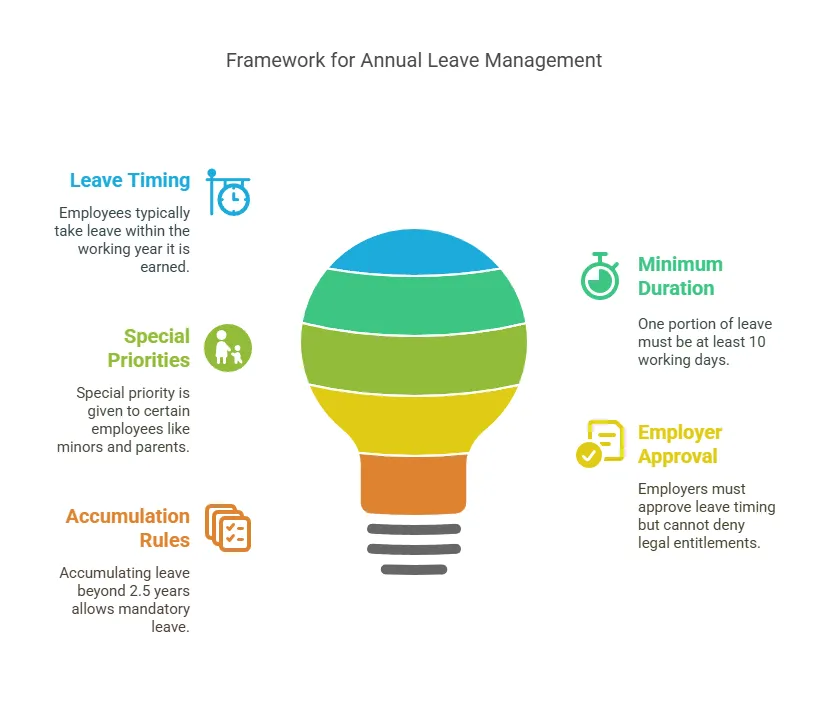
Timing of Leave: Annual leave is generally taken during the working year in which it is earned. The “working year” for each employee is defined as the 12-month period starting from their hire date (anniversary basis). Employers commonly use a leave schedule to plan when employees will take vacations over the year. According to Article 164 of the Labor Code, if there’s a collective agreement it may set out the scheduling procedure; otherwise, the schedule is set by mutual agreement between employer and employee. Employers should plan ahead to ensure business continuity while employees utilize their leave entitlements.
Splitting Leave: Armenian law allows annual leave to be taken in parts, but with an important restriction: one portion of the leave must be a continuous period of at least 10 working days (which is 2 calendar weeks) for a five-day week employee (or 12 working days for a six-day week). This means employers cannot force an employee to split their 20 days into too many small chunks – the employee is legally entitled to at least two weeks of uninterrupted vacation if they wish. For example, an employee with 20 days could take one two-week vacation (10 workdays) and use the remaining 10 days separately (in one or more intervals), or they might take the entire 20 days at once. Splitting into smaller pieces (e.g. 5 days + 5 days + 5 days + 5 days) is possible only if the employee agrees and still gets at least one 10-day block in the year.
Employee Preferences: After six months of employment, certain employees have a legal right to choose their vacation time. Article 164 gives priority to some groups: employees under 18, pregnant employees or those raising a child under 14, and husbands during their wife’s maternity leave, can choose when to take their annual leave. For example, a father can request his annual leave to coincide with the period his wife is on maternity leave, and the employer must grant it. Similarly, employees pursuing education can align vacations with exam periods, and teachers can take leave during school holidays in their first year of work. These provisions ensure work-life balance for those with special family or educational circumstances.
Company Approval: In general, employers have the right to approve the timing of leave based on business needs, as long as the employee gets their full entitlement within the year. It’s best practice to have a clear leave policy or guideline: for instance, requiring leave requests to be submitted in writing at least some weeks in advance, and handling overlapping requests among staff fairly (e.g., first-come-first-served or rotating popular vacation periods). However, keep in mind that if an employee does not take their vacation for an extended period, the employer may eventually step in.
Employer’s Obligation to Ensure Leave Is Taken (Avoiding Accumulation)
Annual leave is intended to be used for rest and cannot be indefinitely postponed. Armenian labor law does not encourage hoarding of leave. In fact, a recent amendment (effective December 1, 2023) introduced a mechanism for employers to ensure employees take their vacation.
Forcing Leave After 2.5 Years: If an employee continuously avoids or refuses to take annual leave for two and a half years, the employer now has the right to unilaterally schedule the employee’s leave in the next period. In simple terms, if someone hasn’t taken any vacation for 30 months straight, the company can require them to go on leave. This situation might arise with workaholic employees or in companies where taking time off was culturally discouraged – the law now pushes for compliance to ensure employee well-being.
Along with this, the employer must pay a penalty fee to that employee for the delay: 0.15% of the employee’s average monthly salary for each day of leave that was postponed beyond the 2.5-year window, up to a maximum of one month’s salary as the penalty. This penalty essentially compensates the employee for not having taken their legally mandated rest on time. It is a strong incentive for employers to encourage annual vacations regularly. Important: This amendment is not retroactive for leave accumulated before Dec 1, 2023 – any backlog of days from earlier periods cannot be forced; only leave accruing after this date falls under the new rule.
Carry-Over of Leave: As a general rule, annual leave should be used in the year it is earned. Automatic carry-over to the next year is not allowed except in specific situations. However, with the employee’s consent (or request), unused leave can be deferred to the next year if business or personal reasons prevented its use in the current year. Article 167 of the Code allows transferring leave by agreement, or if certain valid reasons occurred that made taking leave impossible at the scheduled time. Valid reasons include the employee’s temporary incapacity (illness), maternity leave, performing state duties, or participating in emergency relief work that coincided with the planned vacation. In such cases, the vacation is either rescheduled or extended beyond the original dates.
Example – Carry-over Scenario: An employee was scheduled to take their remaining 10 days of annual leave in late December 2024, but a work emergency (critical project or a co-worker’s sudden absence) required them to postpone. By mutual agreement, the employer and employee move this vacation into January 2025. This is a lawful carry-over because it’s done with consent. The deferred days should ideally be used early in 2025. By contrast, an employer cannot unilaterally push an employee’s 2024 vacation into 2025 just for convenience – it must be agreed, or due to one of the Code’s listed valid reasons. Moreover, even when carried into the next year, it’s recommended to use the deferred leave as soon as possible, rather than accumulating multiple years.
Payment During Annual Leave (Vacation Pay)
Wages during Leave: During paid annual leave, an employee must receive their average wage so that going on holiday does not financially disadvantage them. Armenian law calculates vacation pay based on the employee’s average earnings over the preceding 12 months. In practice, the employer usually computes an average daily wage (considering all regular remuneration in the last 12 months) and multiplies by the number of leave days. This ensures fairness, especially if the employee’s income fluctuates (for example, due to bonuses or variable pay). Legal reference: Article 169 of the Labor Code states the employer must pay the average wage for the number of days of leave.
Timing of Payment: Vacation pay must be paid in advance of the leave – at least three days before the employee’s leave starts. For example, if an employee’s vacation begins on July 15, the employer should pay out the due vacation salary by July 12. This rule helps employees have funds available during their time off. If the employer fails to pay on time (through no fault of the employee), the law says the employee’s leave is extended by the number of days of delay in payment. In other words, if the payment was late by 2 days, the vacation is extended by 2 days (and those extra days are also paid as if they were leave). This is a penalty for late payment and an incentive for employers to pay promptly.
No Work During Leave: By definition, annual leave is a rest period – the employee is not to perform work. The employment position is held for them, and upon return they continue in the same job. The employer should refrain from contacting employees for work matters during their leave except in true emergencies. Recall from leave is only allowed with the employee’s consent. An employee can’t be forced to cut short their vacation, and if they agree to return early, any unused days must be rescheduled for later as per the normal procedure.
Unused Leave and Compensation
Use-It-or-Get-Paid Principle: Armenian law strongly encourages that employees take their minimum annual leave in kind, rather than employers simply paying out vacation days. The Labor Code explicitly states that the minimum annual leave (the 28 calendar days) may not be replaced by monetary compensation during employment. This means an employer cannot skip giving time off by just paying extra salary – employees must be allowed to actually disconnect from work for those days. This is important for compliance: international companies sometimes offer “vacation buy-out” or ask employees to waive vacation for pay – such practices would violate Armenian labor law for the minimum leave entitlement.
The only time payment in lieu of leave is allowed is when an employee is terminating employment (leaving the company) or in the rare case an employee voluntarily opts not to use leave (e.g., perhaps near retirement or contract end). In these cases, any unused leave days must be compensated in cash. For example, if an employee resigns with 10 days of unused vacation, the employer should pay them 10 days’ worth of average wages along with their final paycheck. If the employee instead prefers (and if time allows), they can take those 10 days as their final part of employment (i.e. extend the end date by using vacation), per Article 168. Often, employees choose to be paid out to make the separation immediate, but the law provides the option.
Maintain clear records of each employee’s accrued and used annual leave. Upon termination, calculate exactly how many days were earned versus taken. For instance, if an employee worked half the year and is leaving, they earned half of their annual leave entitlement (about 10 working days out of 20) – pay those out if not taken. Conversely, if an employee took more leave than they had accrued and then resigns, the law doesn’t explicitly address clawing back “excess” vacation pay, but in practice employers might deduct any advance leave from the final settlement if it was clearly agreed as an advance. Always handle such cases carefully and consistent with any clauses in the employment contract.
Practical Example: Overlapping Public Holidays and Annual Leave
One common scenario is when a public holiday occurs during an employee’s annual vacation period. How should this be handled? Under Armenian law, public holidays are separate paid non-working days and should not be counted against an employee’s annual leave entitlement. In practice, this means if a national holiday falls in the middle of someone’s vacation, that day is not “charged” as a vacation day – the employee is entitled to the holiday off in addition to their vacation.
Example Scenario: An employee plans to take two weeks of annual leave from April 21, 2025 to May 4, 2025. Within this interval, there are two public holidays: April 24 (Genocide Remembrance Day) and May 1 (Labor Day) are official non-working holidays in Armenia. The employer should not count April 24 and May 1 as part of the employee’s 10 vacation days. Essentially, the employee will use 8 of their annual leave days for the other workdays in that period, and April 24 and May 1 will be paid holidays. The total time off remains April 21–May 4 (14 calendar days), but only 8 days come from the annual leave balance. The holidays effectively extend the employee’s continuous time off without reducing their vacation quota.
From a compliance standpoint, HR should configure their leave tracking systems accordingly. Many international HRIS systems allow marking public holidays so they don’t deduct from PTO. This approach aligns with the principle that public holidays (11-12 days a year in Armenia) are in addition to annual vacation. Failing to distinguish them could inadvertently shortchange employees’ legal time off.
Another angle: If the company’s policy is to count calendar days for leave (28 calendar days), that already inherently includes weekends and holidays. But since the law ensures those holidays are separate, it’s safer to plan leave in working days. Most companies simply schedule vacation in working days and let the holidays fall where they may. Always double-check each leave request period for any holiday overlap.
Public Holidays in Armenia: Employer Obligations
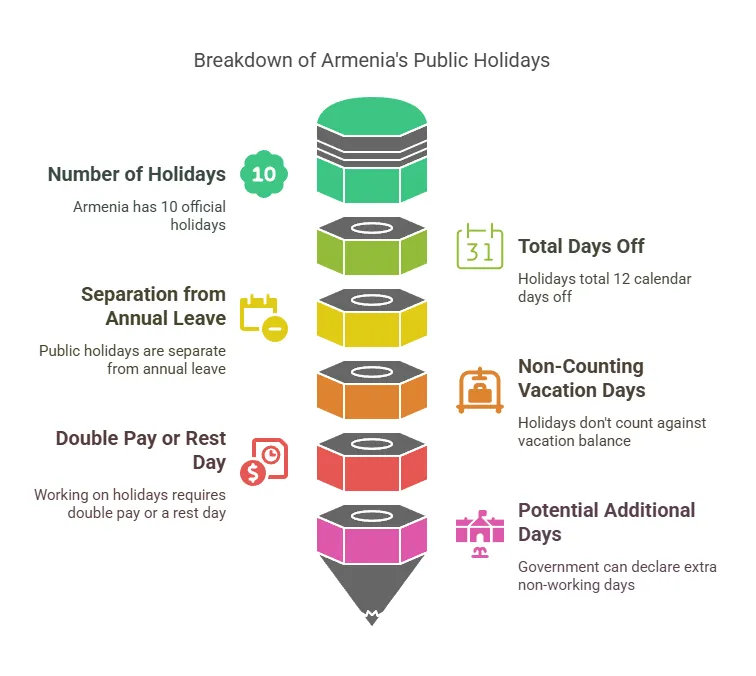
In addition to annual leave, Armenia has a set of official public holidays each year on which employees are entitled to time off. These holidays are established by law and must be granted as paid non-working days. Both local and international employers need to be aware of these dates to plan work schedules, office closures, and payroll (especially for employees who may have to work on a holiday).
Legal Status of Public Holidays
Armenian Labor Code treats public holidays as non-working days with full pay. No work should be performed on these days, except for jobs that cannot be stopped (such as continuous operations, emergency services, etc.) and even then special rules apply. Employers are required to give employees these holidays off with pay. This means an employee’s normal daily wages are paid even though they do not work on a holiday.
If an employee does work on a public holiday (which should be an exception), labor law requires premium compensation. Typically, work on a holiday is considered overtime, payable at least double. Alternatively, the employer can arrange a substitute rest day if the nature of work requires holiday staffing, but in most cases, double pay is the norm for holiday work. For example, if a maintenance engineer must monitor equipment on January 28 (Army Day) which is a public holiday, that engineer should receive 200% pay for that day (or 100% pay plus an alternative day off). Companies should document any holiday work and compensation to ensure compliance.
It’s important to note that public holidays are distinct from the “weekly rest days” (weekends). Armenia generally has a five-day workweek (Monday–Friday) with Saturday and Sunday as rest days for most workplaces. Public holidays may fall on any day of the week and are observed on their calendar date. Unlike some countries, Armenia does not automatically move the holiday to Monday if it falls on a weekend. For instance, if Independence Day (Sept 21) falls on a Sunday, it is generally observed on that Sunday and employees who normally have Sunday off do not get an extra weekday off. However, the government sometimes issues decrees to make a long weekend by swapping workdays – e.g., declaring Monday off and a nearby Saturday a working day – but these are ad hoc decisions and not guaranteed each year. Employers should keep an eye on government announcements for any such calendar adjustments. As of this guide, there is no permanent substitution system, so a public holiday on a weekend is “lost” for employees on a standard schedule.
Official Public Holidays in Armenia
For planning purposes, here is the calendar of official public holidays in Armenia, as defined by law:
January 1 – New Year’s Day
January 2 – New Year’s Day (Day 2)
(Armenia celebrates two days for New Year.)January 6 – Christmas Day (Armenian Christmas and Epiphany)
January 28 – Army Day (Celebration of the National Army)
March 8 – International Women’s Day
April 24 – Armenian Genocide Remembrance Day
May 1 – Labor Day (International Workers’ Day)
May 9 – Victory and Peace Day (WWII Victory Day)
May 28 – Republic Day (First Republic Day)
July 5 – Constitution Day
September 21 – Independence Day (from USSR, 1991)
These are the 10 official holidays recognized by the Labor Code, encompassing 12 calendar days off (since New Year is two days, and all others are one day each). Employers should treat these days as paid non-working days for their staff. It is advisable to circulate an annual holiday schedule to all employees at the beginning of the year (or end of the previous year) listing these dates, so everyone is aware of office closures or special pay arrangements.
Note on Religious Holidays: Armenia, being a country with strong traditions, has other observances (for example, Easter or Vardavar in summer). However, only the above-listed holidays are official non-working days under labor law. For instance, Easter Sunday and Easter Monday are not public holidays by law, so they are considered regular work days unless an employer voluntarily grants a day off. Many employers with Christian values may give Easter Monday off as an extra benefit, but it’s not mandated. The Labor Code even notes that other traditional or religious “memory days” are considered working days unless officially declared otherwise. Therefore, companies should not confuse cultural observances with legal holidays. Always refer to the official list.
Managing Public Holidays in the Workplace
HR and Payroll Considerations: On public holidays, full-time salaried employees generally receive their normal salary with no deductions (the holiday is paid as if they worked). Hourly workers or those on shift work who are given the day off should also be paid for their scheduled hours for that day. Employers should configure payroll systems to either not count the holiday as a leave or absence, or to mark it as paid holiday time. If your company’s workweek is Monday–Friday, note that when a holiday like Women’s Day (March 8) falls on Saturday, employees on that schedule do not need any additional compensation (since Saturday is already a rest day for them). There is no legal requirement for a “day in lieu” in such cases – though an employer may choose to offer one as a perk.
For businesses that operate on weekends (e.g., retail or hospitality), a Saturday or Sunday holiday means those scheduled to work that day must either be given the day off or paid the overtime rate if they do work. Plan staffing well in advance for holidays: Determine if you will close operations entirely or keep minimal staff. If staff must work, inform them of the extra pay or alternative day off they will receive. Clear communication and proper compensation will ensure compliance and maintain employee morale.
International Companies Tip: If you are an international company used to following only, say, U.S. or European holidays, ensure you incorporate the Armenian holidays for your Armenian staff. For example, even if the HQ doesn’t close on January 28 (Army Day), the Armenian office or employees should not be asked to work, unless properly compensated. Many multinational companies maintain a country-specific holiday calendar for each office. Aligning your local policies with Armenian public holidays is not just compliance – it’s also respectful of local culture and events (like commemorating the genocide on April 24 is deeply significant in Armenia).
Bridging Holidays: The Armenian government often makes decisions to create long weekends. For instance, if a holiday falls on Thursday, the government might declare the Friday off and a prior Saturday as a working day to compensate. These decisions are usually announced in advance. Employers, while not legally bound beyond the official holidays, often follow these to align with public sector and general practice. It’s practical to monitor news or official announcements around New Year and May holiday periods for any such arrangements. Although these one-time bridge days are not in the Labor Code, honoring them can simplify operations (since many employees may take off anyway). Always clarify to employees which days are formally holidays versus company-decided days off.
Compliance Tips for Employers and HR Professionals
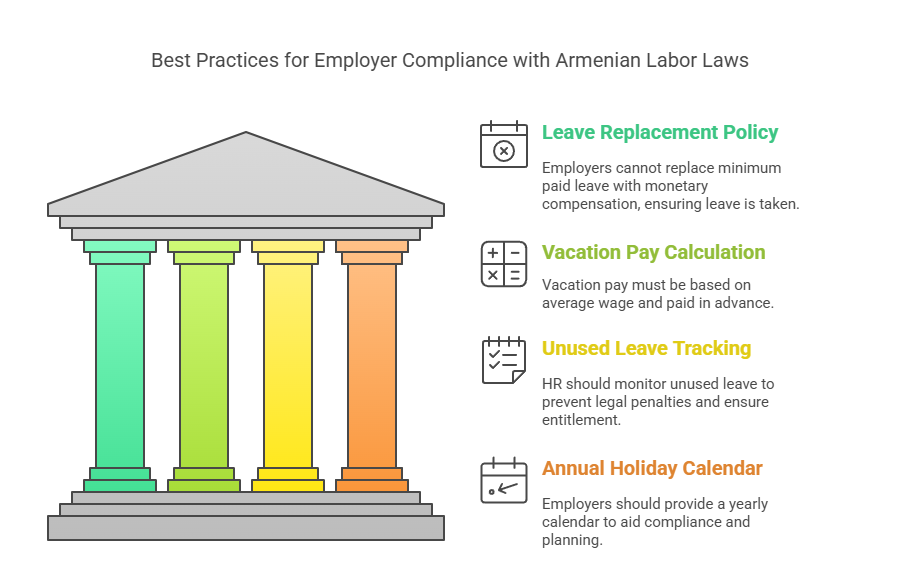
Managing annual leave and public holidays in Armenia requires balancing legal requirements with practical workforce management. Here are some best practices and key compliance tips for international companies and HR teams:
Align Company Policy with Local Law: Review your employment contracts and internal HR policies to make sure the annual leave policy meets the Armenian minimum (20 working days for 5-day week) and that the official holidays are recognized. If your global policy offers more generous leave (e.g. 25 working days), that’s fine (employees can always be given more than the legal minimum), but you cannot go below the local minimum. Clearly state the local Armenian holiday schedule in your company handbook.
Leave Scheduling System: Implement a transparent system for requesting and approving leave. Given the rule that one portion must be 10 working days, encourage employees to take at least a two-week block for wellbeing. As an example, an HR system could prevent an employee from breaking all 20 days into single days off – remind them of the legal requirement of an uninterrupted period. Additionally, consider allowing carry-over only in exceptional cases with written approval, to enforce “use it or lose it” yearly, which aligns with the law’s intent (except where carry-over is allowed by mutual consent).
Tracking Unused Leave: Keep track of leave balances and watch out for employees not taking leave. The new 2.5-year rule means HR should flag anyone who hasn’t taken vacation in, say, 2 years and encourage them to schedule time off. It’s far better to have them take a well-deserved break than to reach the point of forcing leave and paying a penalty. Foster a culture where taking annual leave is supported, not seen as a lack of dedication.
Public Holiday Staffing: Plan ahead for each public holiday. If your operation must run (e.g., IT support, security, hospitality), arrange a rota and inform employees of their rights (like double pay) for holiday work. Otherwise, ensure no meetings or deadlines are set on those dates. Communicate holiday closures early (many businesses issue a memo in December for the next year’s holidays).
Foreign Managers Education: If you have expatriate managers or a foreign HR department, educate them on Armenian leave norms. For example, a manager in another country might not expect that Armenian employees have a legal right to nearly a month of vacation and numerous holidays. Clarify that denying leave or pressuring employees not to take time off would not only be illegal but counterproductive. Emphasize that Armenian public holidays, such as Genocide Remembrance Day, are non-negotiable off-days even if the parent company is open – this is crucial for cultural sensitivity and legal compliance.
Legal References: When in doubt, consult the Armenian Labor Code (particularly Chapters concerning Leave and Holidays). Key articles include Article 159 (leave entitlement), Article 164 (granting leave), Article 169 (vacation pay), and Article 173 (public holidays list – though often referenced in ancillary legislation). Keeping a local legal advisor or consulting official translations can help resolve any ambiguities.

By following the above guidelines, employers and HR professionals can ensure full compliance with Armenian labor laws on annual leave and public holidays. This not only avoids legal penalties but also contributes to a positive work environment where employees can rest and observe important cultural events. Remember that labor law updates can occur – for instance, the 2023 amendments on leave – so stay informed of any changes in 2025 and beyond. When properly managed, annual leave and holidays become a win-win: employees recharge and celebrate traditions, and employers benefit from a healthier, more motivated workforce.
